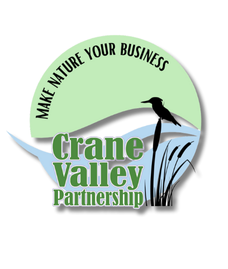Why we need the help of the businesses
The engagement of businesses in the Crane Valley is crucial for allowing the Crane Valley Partnership (CVP) to fully achieve its objectives of restoring the River Crane catchment area. Businesses play a pivotal role in environmental sustainability and community development, providing essential resources, expertise, and funding necessary for successful conservation efforts and habitat restoration projects. Additionally, businesses operating within the catchment area have a vested interest in maintaining environmental health, as it directly impacts their operations, employees, and customers.
What's in it for the businesses?
Engaging in environmental corporate volunteering and conservation efforts in the Crane Valley, your business will:
- Boost Corporate Social Responsibility (CSR)
Engaging in conservation activities in the Crane Valley enhances your company’s CSR profile, showcasing a commitment to protecting the local environment. This strengthens the company’s brand image, demonstrates sustainability leadership, and can attract environmentally-conscious consumers and partners. - Increase Employee Engagement and Team Building
Environmental volunteering provides employees with a meaningful opportunity to bond outside the office while working together for a common cause. Activities like tree planting or litter removal in natural settings foster teamwork, morale, and a sense of accomplishment, leading to higher job satisfaction and retention. - Support Local Biodiversity and Sustainability
The Crane Valley is an important green corridor supporting wildlife and local ecosystems. By engaging in conservation, companies contribute directly to protecting biodiversity, improving the health of habitats, and maintaining a sustainable environment for future generations in the West London area. - Enhance Positive Community Relations
Participation in local environmental projects fosters strong relationships with the surrounding community. By improving green spaces and contributing to local sustainability, companies demonstrate care for the area they operate in, earning goodwill from residents, local councils, and organizations. - Align with ESG (Environmental, Social, Governance) Goals
Many large companies now have ESG goals as part of their strategic priorities. Volunteering in environmental projects aligns with these objectives, helping your company reduce your ecological footprint, promote sustainability, and demonstrate concrete actions in environmental stewardship to stakeholders and investors. There exist several tax breaks and incentives available for companies engaging in community and environmental work in the UK. - Attract Environmentally-Conscious Talent
Companies that actively support environmental causes appeal to the growing number of professionals who prioritize sustainability in their workplace choices. Demonstrating a commitment to environmental causes like conservation in Crane Valley can help attract top talent who value environmental responsibility. - Improve Physical and Mental Wellbeing of Employees
It is scientifically proven that outdoor volunteering in green spaces like Crane Valley provides employees with physical exercise and mental health benefits. Nature-based activities help reduce stress, increase creativity, and improve overall well-being, resulting in a healthier, more productive workforce.
By participating in these efforts, companies can contribute to the protection of a vital natural area while simultaneously strengthening their workforce, community ties, and environmental credentials.
Examples of activities that can be organised and tailored for each business
- Citizen Crane: Citizen Crane is a groundbreaking citizen science project that has been collecting monthly information on the health of the River Crane and Yeading Brook since 2014. Every month volunteers record the types and numbers of key invertebrates at specific locations, under a national programme called the Riverfly Monitoring Initiative (RMI).
- Employee Engagement/Volunteering Days: Companies can request Lgoal’s partners to organise or promote the following for their employees: Tree planting; habitat restoration projects (native planting, wild-life friendly landscaping); trail maintenance; cleaning up natural areas; litter picking; hang "your quote for life" on a tree; name a trail.
- Eco-Friendly Challenges: Challenges or competitions that encourage employees to adopt eco-friendly practices both at work and in their personal lives.
- Environmental Education Workshops: Workshops and seminars on SWC themes: Biodiversity, ecosystems, and conservation practices. Local experts and organisations may be invited to share their knowledge.
- Green Team Formation/SWC Ambassadors: Green teams within the company composed of passionate employees who will promote sustainability and conservation efforts. This team and/or the ambassadors can come up with ideas and initiatives to engage coworkers.
- Local Species Adoption: Adoption of a local species by employees, whether it's a plant, animal, or bird, by learning about it, raising awareness, or contributing to its protection.
- Nature Photography Contest: Nature photography contest for employees, showcasing local flora and fauna.
- Lunch and Learn Sessions: Lunch and learn sessions where employees can hear from local environmental organisations about the Smarter Water Catchment projects.
Partners and local groups delivering programmes and activities
- TCV - The Conservation Volunteers (Ealing, Harrow, Hillingdon, Hounslow, Richmond): Can organise ad hoc volunteering events for employees; businesses can join the association's scheduled activities; businesses can become partners for specific projects. Contact email: corporate-enquiries@tcv.org.uk
- Habitats & Heritages (Ealing, Harrow, Hillingdon, Hounslow, Richmond): Can organise ad hoc volunteering events for employees; businesses can join the association's scheduled activities; businesses can sponsor specific events; businesses can become partners for specific projects; businesses can make donations in kind; businesses can receive advice on green policies and planning. Contact email: hello@habitatsandheritage.org.uk
- London Wildlife Trust (Ealing, Hillingdon, Hounslow, Richmond): Can organise ad hoc volunteering events for employees; businesses can sponsor specific events. Contact email: psalter@wildlondon.org.uk
- Lampton Services (Hounslow): Can organise ad hoc volunteering events for employees; businesses can join the association's scheduled activities; businesses can sponsor specific events; businesses can become partners for specific projects. Contact email: countryside@hounslow.gov.uk
- Gurseva (Ealing, Harrow, Hillingdon, Hounslow): Can organise ad hoc volunteering events for employees; businesses can join the association's scheduled activities; businesses can become partners for specific projects. Contact email: Info@gurseva.org.uk
- Crane Valley CIC (Ealing, Harrow, Hillingdon, Hounslow, Richmond): Businesses can become partners for specific projects; businesses can be guided in receiving advice on green policies and planning. Contact email: cvp@cvcic.org.uk
- FORCE (Ealing, Harrow, Hillingdon, Hounslow, Richmond): Businesses can become partners for specific projects; businesses can be guided in receiving advice on green policies and planning. Contact email: info@force.org.uk
- Creative and Connected Communities CIC (Ealing, Hillingdon, Hounslow): Can organise ad hoc volunteering events for employees; businesses can join the association's scheduled activities; businesses can sponsor specific events; businesses can become partners for specific projects; businesses can make donations in kind. Contact email:
- Harrow Heritage Trust and Harrow Nature Conservation Forum (Harrow): Can organise ad hoc volunteering events for employees. Contact email: info@harrowheritagetrust.org.uk Contact email: admin@harrowncf.org
- The Friends of Headstone Manor Park (Harrow): Businesses can join the association's scheduled activities; businesses can sponsor specific events. Contact email: fohmrg@gmail.com
- Sunshine of Hounslow (Hounslow): Can organise ad hoc volunteering events for employees; businesses can join the association's scheduled activities; businesses can sponsor specific events; businesses can become partners for specific projects; businesses can make donations in kind. Contact form.
Who's the right match for you?
Share your goals and requirements by completing our short brief form below. We’ll use this information to connect you with the partner(s) best suited to design and deliver Corporate Volunteering programs and events that align with your needs.
In the meantime, do check out our "21 Things to Do in the Crane Valley during your Lunch Break" booklet!
Other citizen science opportunities for individual or teams of employees
- Bird Monitoring: Employees can participate in birdwatching and bird counting programs, such as the Audubon Society's Great Backyard Bird Count. They can document bird species and numbers in their local areas, which contributes to important avian research.
- Butterfly and Pollinator Surveys: Employees can help monitor and report on butterfly populations and other pollinators like bees. Initiatives like the Monarch Watch or Bumble Bee Watch rely on citizen scientists to collect data.
- Water Quality Testing: Employees participate in water quality testing projects where they collect water samples from local rivers, streams, or ponds. Organisations like the FreshWater Watch and The Big River Watch provide resources for such efforts.
- Wildlife Tracking: Employees can track animal movements and signs in their local area, contributing data to wildlife conservation efforts. Projects like eMammal involve setting up camera traps to capture images of wildlife.
- Plant and Tree Identification: Employees can participate in projects that involve identifying and cataloging local plant and tree species. This data can be used for ecological research and conservation planning.
- Air Quality Monitoring: Employees can use air quality monitoring kits to measure pollutants like particulate matter and contribute to air quality research. Programs like AirVisual offer resources for citizen scientists.
- Climate Observations: Employees can collect and report climate-related data, such as temperature, precipitation, and weather conditions. The National Weather Service and apps like iNaturalist allow users to submit observations.
- Bat Monitoring: Employees can participate in bat monitoring programs by setting up bat detectors or conducting bat counts, which helps with bat conservation efforts.
- Mapping and GIS: Employees can help create maps and gather geographic information through projects like OpenStreetMap, which can be valuable for disaster response, conservation, and urban planning.
- BioBlitz Events: Employee can participate in BioBlitz events, where teams work together to identify as many species as possible within a designated area and timeframe.
- Community Science Fairs: Science fairs or events where employees can showcase their citizen science contributions and learn from each other.
- Go to the CVP website for more ideas!
Contacts
Email: business@lgoal.org.uk
Tel: 075 182 49083
Social Media

